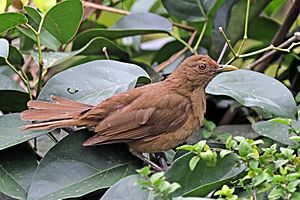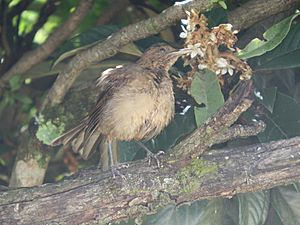Clay-colored thrush facts for kids
Quick facts for kids Clay-colored thrush |
|
|---|---|
 |
|
| In Panama | |
| Conservation status | |
| Scientific classification | |
| Genus: |
Turdus
|
| Species: |
grayi
|
 |
|
The clay-colored thrush (Turdus grayi) is a common bird found in Central America. It belongs to the thrush family, known as Turdidae. This bird is very special because it is the national bird of Costa Rica. In Costa Rica, people know it well by its local name, yigüirro (which is Spanish). Sometimes, it's also called the clay-colored robin.
You can find the clay-colored thrush from South Texas all the way down to northern Colombia. It is quickly spreading its home range in Texas. Usually, it lives on the Atlantic side of Central America, but there's also a group of them near Oaxaca City, Mexico. These birds probably came from pet birds that escaped.
Contents
What Does It Look Like?
The clay-colored thrush looks and acts a lot like other thrushes, such as the American robin. It is about the same size or a little smaller than the American robin.
Size and Weight
These birds are usually about 23–27 cm (9.1–10.6 in) long. They weigh around 74–76 g (2.6–2.7 oz).
Feathers and Colors
Their feathers are mostly brownish. They are a bit lighter on their belly than on their back. The lightest parts are on their sides. Birds that live in wet areas tend to have darker feathers than those in dry places. Their throat has faint streaks, which are like thin lines. Young birds have light spots on their back and belly.
Beak, Legs, and Eyes
The beak of a clay-colored thrush is greenish-yellow with a dark part near its head. Their legs are pinkish or flesh-colored. Their eyes are reddish. These features can help you identify them!
Its Song
The song of the clay-colored thrush is quite low-pitched and has a slow, steady rhythm. It sings many smooth, musical phrases. These phrases are often repeated, but not always in the same order. Its flight call, which sounds like "tock," is similar to the American robin's call but a bit rougher.
Where Does It Live and What Does It Do?

In many places, you can see the clay-colored thrush in yards and gardens. It's like other common thrushes, such as the American robin or the Eurasian blackbird.
A National Symbol
In 1977, the people of Costa Rica chose the yigüirro as their national symbol. This was a big deal because Costa Rica has many other colorful birds! They chose it because of its strong and beautiful song. This song always signals the start of the rainy season. Also, unlike many forest birds in Costa Rica, the yigüirro has always lived close to people's homes. This means people have known and loved this bird for a very long time.
What It Eats
The clay-colored thrush usually looks for food on the ground or very close to it. It eats fruits or small creatures without backbones, like worms or insects. It often forages alone or in pairs. However, sometimes groups of them will gather to eat fruit high up in trees. They might even follow army ants. This is because army ants disturb small prey, making it easier for the thrush to catch them.
Building a Nest
This bird builds a strong, cup-shaped nest. It uses grass, moss, feathers, leaves, and mud. The nest is built on a sturdy support above the ground. Sometimes, they even build their nests on human structures, like windowsills!
Eggs and Chicks
The female lays 2 to 4 pale blue eggs. These eggs have red-brown and gray markings. They lay their eggs between March and July. A pair might even raise two groups of chicks in one season.
Protecting Its Home
The clay-colored thrush is very protective of its nest. It has been known to chase away large birds of prey, even ones as big as golden eagles! However, it is not very territorial otherwise. It defends its nest well against other birds that try to lay their eggs in its nest, like the bronzed cowbird.
Images for kids
See also
 In Spanish: Yigüirro para niños
In Spanish: Yigüirro para niños



